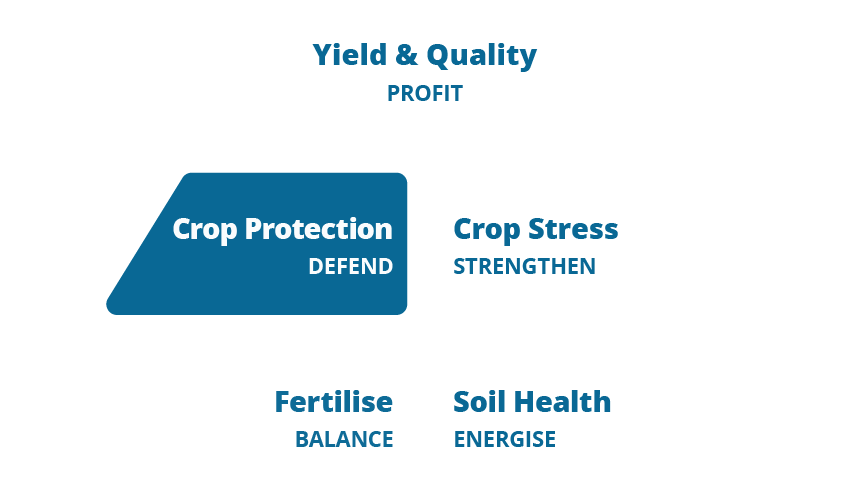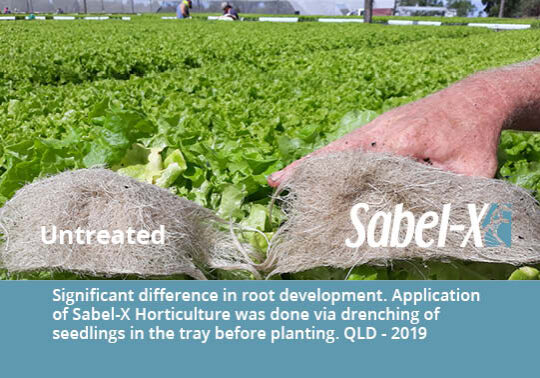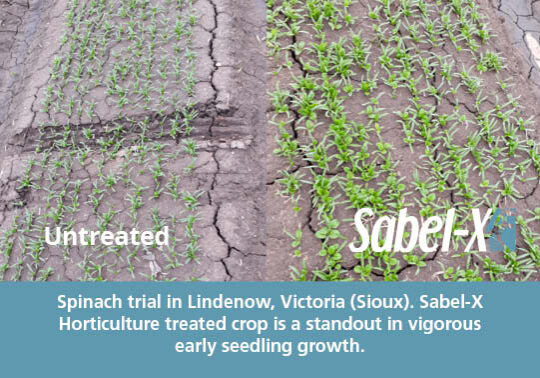Protect Your Crops To Improve Yield
Strengthen your plants defenses and utilise beneficial microbes.
Pests and disease can significantly damage your crop quality and yield.
Defensive supports can be above ground, such as strengthening the leaf surface against pests and disease. Or defences can be below ground, for example colonising root systems with beneficial microbes to compete with pathogens.
Protecting plants at critical early stages in the growth cycle builds the strength of the plant’s self-defence systems.
Stronger defence means less need for chemicals.

Protection Strategies
Crop yield can be badly affected by pests and disease. Insecticides, fumigation and fungicides can counter them with varying degrees of success.
Crop protection strategies harness the power of nature by:
- Strengthening: Silicon and Potassium, when used at the right time, help enhance the plant's own defenses
- Beneficial Microbes : incorporate beneficial microbes to boost root systems and compete directly with pathogens (for example, Endophytic Trichoderma, Mycorrhizal Fungi)
Microbes - next generation Endophytic Trichoderma
Endophytic Trichoderma are now available in Australia under the brand name Sabel-X. They are considered the next generation of Trichoderma because they live within the plant instead of in the soil.
Sabel-X Endophytic Trichoderma are a game changer Trichoderma, providing exceptional ROI.
Sabel-X Trichoderma directly interact with the gene expression inside the plant, switching on gene pathways depending on what the plant needs, resulting in consistently improved yields.
Sabel-X Trichoderma are robust. They are microencapsulated for quick colonisation, protected from fertiliser and pesticide applications as they live within the plant, and usually require only one application as they have the same longevity as the plant.
Exceptional grower feedback has been the hallmark of this unique product, with Kevin Dobra from The Loose-Leaf Lettuce Company reporting, “We had been losing 80% of our crop (spinach) and now we’ve got losses down to about 2%”.
Results including improved yields, improved establishment, improved germination, increased density, improved tolerance to stress and stronger plants, are being mirrored around the country for spinach and lettuce growers.
The Sabel-X Trichoderma are established inside the plant within 16-48 hours, which means the Trichoderma are protected from negative soil conditions, and from fertiliser and pesticide applications.
The strains of Endophytic Trichoderma chosen for Sabel-X are the result of 30+ years of methodical research on Trichoderma at Cornell University.
New technologies that track the switching on of the gene pathways show that Sabel-X Trichoderma switch on specific positive gene pathways depending on what the plant requires.
The gene pathways that can be switched on by the Trichoderma have a positive impact on germination, plant nutrition, water utilisation, growth and vigour, photosynthesis, root development, disease resistance, stress resistance, yield and quality.
This direct relationship Sabel-X Trichoderma have with the plant means different species & strains of Trichoderma are suitable for different plant types, which is not unlike Rhizobium which have different strains for different legumes.
Sabel-X Horticulture contains effective strains for all fruit trees, vegetables (except corn), nut crops, vines and legumes. There are another four different crop specific types in the Sabel-X quintet for corn, cereals canola and cotton.
Potassium in plants
Potassium (K) is essential for translocation of sugars and starch formation. Potassium is also required for leaf stomata opening/closing, strengthens plants and improves plant resistance to drought and disease.
Application of Grosil potassium silicate improves leaf erectness, reduces susceptibility to lodging in grasses, and also improves photosynthesis efficiency.
Crops that have demonstrated beneficial response to soluble silicate application include:
- Vegetables - Capsicum, tomatoes, green beans, lettuce, corn, cucumber, melon, pumpkin, zucchini
- Fruit - Citrus, strawberries, grapes, apples
- Broad-acre - Rice, wheat, oats, barley, millet, cotton, sugar cane, soybeans, sorghum, maize
- Ornamentals - Turf grass, roses, palm, umbrella tree, dandelion and other ornamental plants.
Silicon in plants
Silicon exists in all plants and plant tissue content has been measured at between 0.1 to 10 %. Silicon enters plants via the leaf and/or root systems and accumulates around the epidermis of roots and shoots.
It forms a silica matrix causing a thickening of the epidermal layers resulting in stronger plants more able to reduce lodging and an increased ability to handle stress conditions.
The function of Silicon is to protect the plant from various biotic and abiotic stresses. The effect of plant available Silicon on plant growth becomes obvious under stress conditions but usually not under non-stressed conditions. (Epstein 1994).
How potassium silicates increase resistance to stress:
- The mechanical barrier provided by silica deposition in the cell wall makes is difficult for pathogens to penetrate.
- Biochemical responses in the plant’s stress signaling system are induced by Si. These vary depending on the particular stress eg can produces phenolics and phytoalexins in response to fungal attack and can enhance activity of chitinases, peroxidases and pholyphenolxidases in response to pythium.
- Si reduced cuticular transpirational water loss by depositing Si beneath the cuticle.
- Si decreases uptake of toxic minerals due to deposits of Si in the root.
- Si enhances stem strength, making it easier to hold more weight. As the plant builds itself up with Potassium Silicate, the plant is able to balance nutrient uptake and increase chlorophyll and RUBP caboxylase in leaves.


